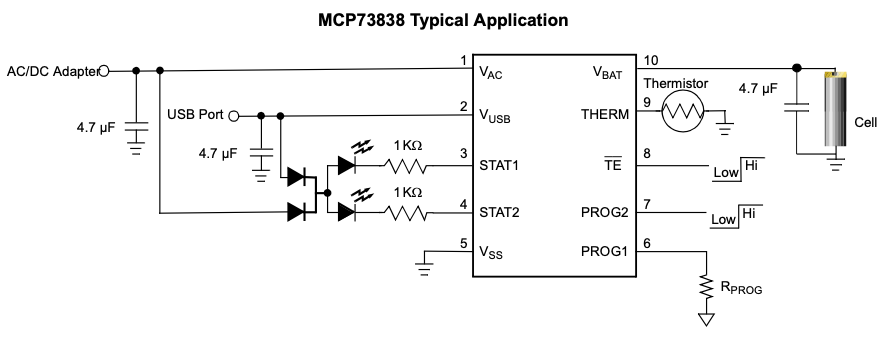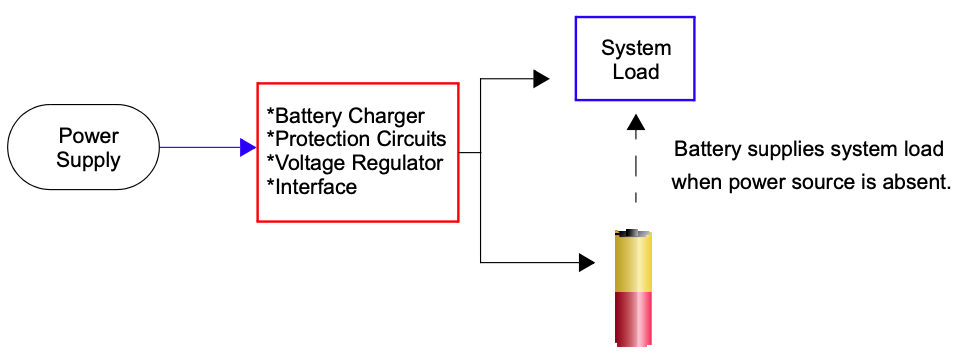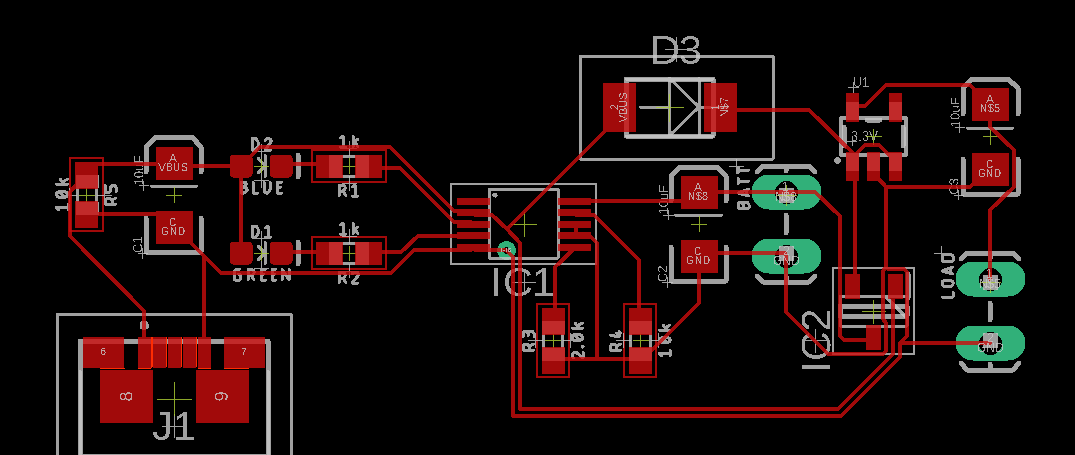With this design I wanted to address these problems:
- Charge a 3.7 V Li-Ion/Li-Po Battery at maximum 4.2 V through USB.
- Be able to use the device that use this circuit while it's recharging the battery without problems.
- The circuit must have an output of 3.3 V.
This is the scheme of the circuit:

The heart of the design is the MCP73838, this IC is a battery charge management controller, it requires a few elements to work, the typical application (available in the datasheet) circuit is:

As my intention is charge through USB I just ignored all the AC configuration like the double diode with common cathode and the Vc connection, pin 3 and 4 indicates the actual state of the charging process and faults:
| Mde | Stat 1 (Pin 3) | Stat 2 (pin 2) |
| Standby | High Resistance | High Resistance |
| Precondition | LOW | High Resistance |
| Fast Charge | LOW | High Resistance |
| Charge Complete | High Resistance | LOW |
| Temperature Fault | High Resistance | High Resistance |
As you can see the information provided by the leds can be misunderstood, like standby and temperature fault, but I easy to see what state really is because standby us when you hasn't connected the battery. In my design the STAT2 pin is connected to a green led and STAT1 led is connected to a blue led (why not red? I don't remember, I'm still wondering xD).
TE pin is set to low to activate the built-in safety timer of four, six or eight hours (depends on the model) that put the charge IC in standby, ROG2 pin is set do low as well because the AC functionalities are not used, PROG1 is connected to a resistance to set the current that is supplied to the battery, in this a value of 2K ohms was selected to provide 500 mA (recommended 0.5C of the battery), the equation used is the 4.1 available in the datasheet:
The other part of the circuit is intended to be a load sharing system (more detailed information in the application note, some pictures presented are form it), the VBUS (voltage supply from the USB) must supply the load when its present, if not, the battery energize the load:

Is important to follow the scheme of image above because if you connect the load directly to the battery a very important issue appears, the battery charger can be confused and keep recharging the battery even if it already at full charged this is dangerous, this phenomena happens because the MCP73838 automatic end the charging process at a specific current value:

So a PMOS circuit based is proposed to avoid any current problem:

The PMOS gate is set to 0 V through a pull-down resistor (R5), this make sure that the mos turn on when VBUS is absent, ion this situation the battery energize the load, due that the transistor is not ideal it has a maximum dropout voltage of 1.1 V (typical 750 mV), this is one of my mayor issues because in the worst case scenario the maximum voltage supply for the 3V3 regulator is 3.6 V (and typically 3.95 V), but in the practice I never notice it, in the example log the device works just well for a weak or more until it get discharge. Continuing with the circuit, if the VBUS is at 5 V (maximum 6 due the IC battery management system specifications) the PMOS get off and the load is energize by the USB supply, the diode has a forward voltage of maximum 520 mV, so the voltage in the IN pin of the 3V3 regulator is 4.48 V, it really doesn't matter because it is a constant voltage, other factor that this diode is useful is to avoid a current flow source to gate or VBATT to VBUS, nevertheless there is still a leak of 50 uA (worst case scenario), this generate a voltage through R5 of 500 mV, its a safe value because it doesn't turn off the most. Finally the 3V3 regulator has a dropout voltage of 400 mV maximum, so the input must be above 3.7 V (typically is 250mV that implies Vin of 3.55 V), the biggest allowed current is 600 mA, so keep that in mind if you want to use it.
And that's all guys, all the information and files are available in the files section, any suggestion and opinions are welcome.

 Maximiliano Rojas
Maximiliano Rojas
Discussions
Become a Hackaday.io Member
Create an account to leave a comment. Already have an account? Log In.